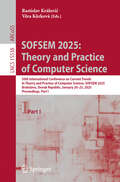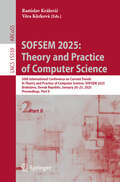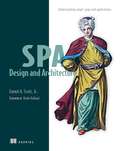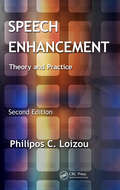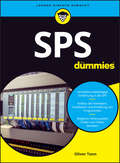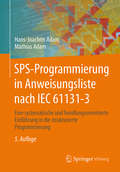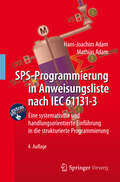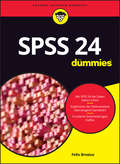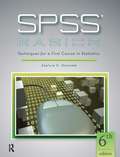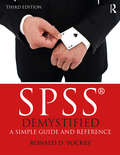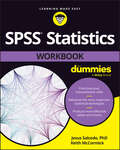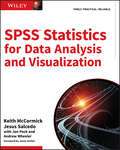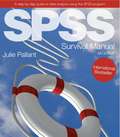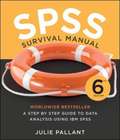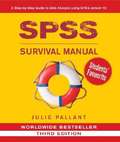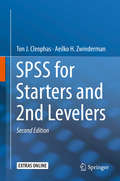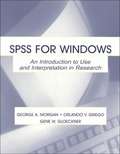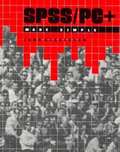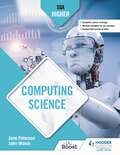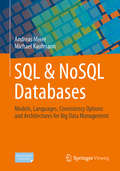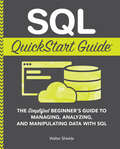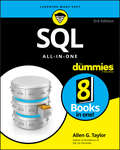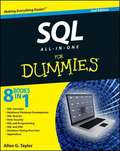- Table View
- List View
SOFSEM 2025: 50th International Conference on Current Trends in Theory and Practice of Computer Science, SOFSEM 2025, Bratislava, Slovak Republic, January 20–23, 2025, Proceedings, Part I (Lecture Notes in Computer Science #15538)
by Věra Kůrková Rastislav KrálovičThis book constitutes the proceedings of the 50th International Conference on Current Trends in Theory and Practice of Computer Science, SOFSEM 2025, held in Bratislava, Slovak Republic, during January 20-23, 2025. The 48 full papers presented in this book were carefully reviewed and selected from 109 submissions. They include original research from all areas of foundations of computer science and artificial intelligence focusing on AI-based algorithms and techniques, nature-inspired computing, machine learning theory, multi-agent algorithms and games, neural network theory, parallel and distributed computing, quantum computing, computability, decidability, classical and non-classical models of computation, computational complexity, computational learning, cryptographic techniques and security, data compression, data and pattern mining methods, discrete combinatorial optimization, automata, languages, machine models, rewriting systems, efficient data structures, graph structure and algorithms, logics of computation, robotics, and other relevant theory topics in computing and AI.
SOFSEM 2025: 50th International Conference on Current Trends in Theory and Practice of Computer Science, SOFSEM 2025, Bratislava, Slovak Republic, January 20–23, 2025, Proceedings, Part II (Lecture Notes in Computer Science #15539)
by Věra Kůrková Rastislav KrálovičThis book constitutes the proceedings of the 50th International Conference on Current Trends in Theory and Practice of Computer Science, SOFSEM 2025, held in Bratislava, Slovak Republic, during January 20-23, 2025. The 48 full papers presented in this book were carefully reviewed and selected from 109 submissions. They include original research from all areas of foundations of computer science and artificial intelligence focusing on AI-based algorithms and techniques, nature-inspired computing, machine learning theory, multi-agent algorithms and games, neural network theory, parallel and distributed computing, quantum computing, computability, decidability, classical and non-classical models of computation, computational complexity, computational learning, cryptographic techniques and security, data compression, data and pattern mining methods, discrete combinatorial optimization, automata, languages, machine models, rewriting systems, efficient data structures, graph structure and algorithms, logics of computation, robotics, and other relevant theory topics in computing and AI.
SPA Design and Architecture: Understanding single-page web applications
by Emmit A. Scott, Jr.SummarySPA Design and Architecture teaches you the design and development skills you need to create SPAs. Includes an overview of MV* frameworks, unit testing, routing, layout management, data access, pub/sub, and client-side task automation. This book is full of easy-to-follow examples you can apply to the library or framework of your choice.Purchase of the print book includes a free eBook in PDF, Kindle, and ePub formats from Manning Publications.About the TechnologyThe next step in the development of web-based software, single-page web applications deliver the sleekness and fluidity of a native desktop application in a browser. If you're ready to make the leap from traditional web applications to SPAs, but don't know where to begin, this book will get you going.About the BookSPA Design and Architecture teaches you the design and development skills you need to create SPAs. You'll start with an introduction to the SPA model and see how it builds on the standard approach using linked pages. The author guides you through the practical issues of building an SPA, including an overview of MV* frameworks, unit testing, routing, layout management, data access, pub/sub, and client-side task automation. This book is full of easy-to-follow examples you can apply to the library or framework of your choice.What's InsideWorking with modular JavaScriptUnderstanding MV* frameworksLayout managementClient-side task automationTesting SPAsAbout the ReaderThis book assumes you are a web developer and know JavaScript basics.About the AuthorEmmit Scott is a senior software engineer and architect with experience building large-scale, web-based applications.Table of ContentsPART 1 THE BASICSWhat is a single-page application?The role of MV* frameworksModular JavaScriptPART 2 CORE CONCEPTSNavigating the single pageView composition and layoutInter-module interactionCommunicating with the serverUnit testingClient-side task automationAPPENDIXESEmployee directory example walk-throughReview of the XMLHttpRequest APIChapter 7 server-side setup and summaryInstalling Node.js and Gulp.js
SPEECH ENHANCEMENT: Theory And Practice
by Philipos C. LoizouWith the proliferation of mobile devices and hearing devices, including hearing aids and cochlear implants, there is a growing and pressing need to design algorithms that can improve speech intelligibility without sacrificing quality. Responding to this need, Speech Enhancement: Theory and Practice, Second Edition introduces readers to the basic problems of speech enhancement and the various algorithms proposed to solve these problems. Updated and expanded, this second edition of the bestselling textbook broadens its scope to include evaluation measures and enhancement algorithms aimed at improving speech intelligibility. Fundamentals, Algorithms, Evaluation, and Future Steps Organized into four parts, the book begins with a review of the fundamentals needed to understand and design better speech enhancement algorithms. The second part describes all the major enhancement algorithms and, because these require an estimate of the noise spectrum, also covers noise estimation algorithms. The third part of the book looks at the measures used to assess the performance, in terms of speech quality and intelligibility, of speech enhancement methods. It also evaluates and compares several of the algorithms. The fourth part presents binary mask algorithms for improving speech intelligibility under ideal conditions. In addition, it suggests steps that can be taken to realize the full potential of these algorithms under realistic conditions.
SPS für Dummies (Für Dummies)
by Oliver TonnSPS ohne Stress Wenn Sie Maschinen oder Anlagen mithilfe einer SPS auch ohne Vorkenntnisse steuern möchten, dann ist dieses Buch für Sie gemacht. Ob Aufbau der Hardware, Installation und Verdrahtung oder Erstellung von Programmen: Jederzeit leicht verständlich erläutert Ihnen Oliver Tonn Grundlagen und fortgeschrittene Techniken der SPS-Programmierung. Dabei lernen Sie SPS sowohl herstellerunabhängig kennen als auch Besonderheiten der verschiedenen Hersteller. Mit zahlreichen Praxisbeispielen vertiefen Sie Ihr Wissen und wenden es schon bald in komplexeren Szenarien erfolgreich an. Sie erfahren Wie Sie ein SPS-Projekt und -Programm erstellen Wie Sie einen Antrieb steuern Wie Sie mit TwinCAT 3 und TIA visualisieren Wie Sie Fehler vermeiden und beheben
SPS-Programmierung in Anweisungsliste nach IEC 61131-3
by Hans-Joachim Adam Mathias AdamDas Lehr- und Übungsbuch vermittelt solides Grundwissen und umfassende praktische Fähigkeiten bei der SPS-Programmierung. Im Anschluss an vier Kapitel, die die verschiedenen Zahlensysteme sowie die Digitaltechnik behandeln, folgen Programmierbeispiele: Schaltnetze, Signalspeicher, Zeitfunktionen, Zähler, Funktionsbausteine und Funktionen, Programmstrukturen, Ablaufsteuerungen u. a. Mit der im Internet bereitgestellten Simulationssoftware und den Musterlösungen können Leser das erworbene Wissen direkt anwenden.
SPS-Programmierung in Anweisungsliste nach IEC 61131-3: Eine systematische und handlungsorientierte Einführung in die strukturierte Programmierung
by Hans-Joachim Adam Mathias AdamDas Lehr- und Übungsbuch vermittelt solides Grundwissen und umfassende praktische Fähigkeiten bei der SPS-Programmierung. Im Anschluss an vier Kapitel, die die verschiedenen Zahlensysteme sowie die Digitaltechnik behandeln, folgen Programmierbeispiele: Schaltnetze, Signalspeicher, Zeitfunktionen, Zähler, Funktionsbausteine und Funktionen, Programmstrukturen, Ablaufsteuerungen u. a. Mit der im Internet bereitgestellten Simulationssoftware und den Musterlösungen können Leser das erworbene Wissen direkt anwenden.
SPSS 24 für Dummies (Für Dummies)
by Felix BrosiusOb Kundendaten oder Absatzzahlen, Umfrageergebnisse oder wissenschaftliche Studien - große Datenmengen lassen sich am besten mit SPSS untersuchen, dem am häufigsten eingesetzten Softwaretool zur statistischen Datenanalyse. Mit "SPSS 24 für Dummies" erhalten Sie eine unterhaltsam geschriebene und zugleich sehr fundierte Einführung in dieses mächtige Programm. Werten Sie Daten professionell aus, kommen Sie auf dieser Basis zu belastbaren Ergebnissen, die Grundlage für Ihre Entscheidungen sein können, und machen Sie so umfangreiche Datenmengen zu wichtigen Informationsquellen.
SPSS Basics: Techniques for a First Course in Statistics
by Zealure C. HolcombThis text takes the guesswork out of using SPSS, with screenshots that show each step for calculating each statistic. It includes extensive coverage of how to format raw SPSS output for inclusion in research reports. End-of-chapter exercises help students master their newly acquired skills. An instructor's answer key will be included with each complimentary examination copy. New to this edition: This edition includes an abundance of instructional screenshots, all of which have been updated to reflect the new look of IBM SPSS Statistics Version 23. Instructor ancillaries that accompany this text include PowerPoints for classroom instruction, and test banks in text format and importable to Respondus.
SPSS Demystified: A Simple Guide and Reference (Third Edition)
by Ronald D. Yockey<p>Without question, statistics is one of the most challenging courses for students in the social and behavioral sciences. Enrolling in their first statistics course, students are often apprehensive or extremely anxious toward the subject matter. And while SPSS is one of the more easy-to-use statistical software programs available, for anxious students who realize they not only have to learn statistics but also new software, the task can seem insurmountable. Keenly aware of students’ anxiety with statistics (and the fact that this anxiety can affect performance), Ronald D. Yockey has written SPSS Demystified: A Simple Guide and Reference, now in its third edition. Through a comprehensive, step-by-step approach, this text is consistently and specifically designed to both alleviate anxiety toward the subject matter and build a successful experience analyzing data in SPSS. <p>Key features of the text: <p> <li>Step-by-step instruction and screenshots <li>Designed to be hands-on with the user performing the analyses alongside on their computer as they read through each chapter <li>Call-out boxes provided, highlighting important information as appropriate <li>SPSS output explained, with written results provided using the popular, widely recognized APA format <li>End-of-chapter exercises included, allowing for additional practice</li> <p> <p>Features and updates to this edition include: material updated to IBM SPSS 24 (available Fall 2016), including screenshots and data sets/end-of-chapter exercises.</p>
SPSS Statistics Workbook For Dummies
by Jesus Salcedo Keith McCormickPractice making sense of data with IBM’s SPSS Statistics software SPSS Statistics Workbook For Dummies gives you the practice you need to navigate the leading statistical software suite. Data management and analysis, advanced analytics, business intelligence—SPSS is a powerhouse of a research platform, and this book helps you master the fundamentals and analyze data more effectively. You’ll work through practice problems that help you understand the calculations you need to perform, complete predictive analyses, and produce informative graphs. This workbook gives you hands-on exercises to hone your statistical analysis skills with SPSS Statistics 28. Plus, explanations and insider tips help you navigate the software with ease. Practical and easy-to-understand, in classic Dummies style. Practice organizing, analyzing, and graphing data Learn to write, edit, and format SPSS syntax Explore the upgrades and features new to SPSS 28 Try your hand at advanced data analysis proceduresFor academics using SPSS for research, business analysts and market researchers looking to extract valuable insights from data, and anyone with a hankering for more stats practice.
SPSS Statistics for Data Analysis and Visualization
by Andrew Wheeler Keith Mccormick Jesus Salcedo Jason Verlen Jon PeckDive deeper into SPSS Statistics for more efficient, accurate, and sophisticated data analysis and visualization SPSS Statistics for Data Analysis and Visualization goes beyond the basics of SPSS Statistics to show you advanced techniques that exploit the full capabilities of SPSS. The authors explain when and why to use each technique, and then walk you through the execution with a pragmatic, nuts and bolts example. Coverage includes extensive, in-depth discussion of advanced statistical techniques, data visualization, predictive analytics, and SPSS programming, including automation and integration with other languages like R and Python. You'll learn the best methods to power through an analysis, with more efficient, elegant, and accurate code. IBM SPSS Statistics is complex: true mastery requires a deep understanding of statistical theory, the user interface, and programming. Most users don't encounter all of the methods SPSS offers, leaving many little-known modules undiscovered. This book walks you through tools you may have never noticed, and shows you how they can be used to streamline your workflow and enable you to produce more accurate results. Conduct a more efficient and accurate analysis Display complex relationships and create better visualizations Model complex interactions and master predictive analytics Integrate R and Python with SPSS Statistics for more efficient, more powerful code These "hidden tools" can help you produce charts that simply wouldn't be possible any other way, and the support for other programming languages gives you better options for solving complex problems. If you're ready to take advantage of everything this powerful software package has to offer, SPSS Statistics for Data Analysis and Visualization is the expert-led training you need.
SPSS Survival Manual
by Julie PallantThis guide book provides a reference source to enable students not only to navigate but understand statistical analysis performed in and output produced by SPSS.
SPSS Survival Manual: A Step By Step Guide to Data Analysis Using IBM SPSS
by Julie PallantThe SPSS Survival Manual throws a lifeline to students and researchers grappling with this powerful data analysis software. In her bestselling guide, Julie Pallant guides you through the entire research process, helping you choose the right data analysis technique for your project. From the formulation of research questions, to the design of the study and analysis of data, to reporting the results, Julie discusses basic and advanced statistical techniques. She outlines each technique clearly, with step- by-step procedures for performing the analysis, a detailed guide to interpreting data output and an example of how to present the results in a report. For both beginners and experienced users in psychology, sociology, health sciences, medicine, education, business and related disciplines, the SPSS Survival Manual is an essential text. Illustrated with screen grabs, examples of output and tips, it is supported by a website with sample data and guidelines on report writing. This sixth edition is fully revised and updated to accommodate changes to IBM SPSS procedures, screens and output. It covers new SPSS tools for generating graphs and non-parametric statistics, importing data, and calculating dates.
SPSS Survival Manual: A Step By Step Guide to Data Analysis Using SPSS for Windows
by Julie PallantIn this fully revised edition of her bestselling text, Julie Pallant guides you through the entire research process, helping you choose the right data analysis technique for your project. From the formulation of research questions, to the design of the study and analysis of data, to reporting the results, Julie discusses basic and advanced statistical techniques. She outlines each technique clearly, with step-by-step procedures for performing the analysis, a detailed guide to interpreting SPSS output and an example of how to present the results in a report. For both beginners and experienced SPSS users in psychology, sociology, health sciences, medicine, education, business and related disciplines, the SPSS Survival Manual is an essential guide. Illustrated with screen grabs, examples of output and tips, it is supported by a website with sample data and guidelines on report writing. In this third edition all chapters have been updated to accommodate changes to SPSS procedures, screens and output in version 15. A new flowchart is included for SPSS procedures, and factor analysis procedures have been streamlined. It also includes more examples and material on syntax. Additional data files are available on the book's supporting website.
SPSS for Starters
by Aeilko H. Zwinderman Ton J. CleophasThis small book contains all statistical tests that are relevant for starters on SPSS. Each test is explained using a data example from clinical practice, including every step in SPSS and the main tables of results with an accompanying text with interpretations of the results and hints convenient for data reporting, i.e., scientific clinical articles and poster presentations.. In order to facilitate the use of this cookbook the data files of the examples are made available by the publisher on the Internet. For investigators who wish to perform their own data analyses from the very start the book can be used as a step-by-step guideline. They can enter their separate data or enter their entire data file, e.g., from Excel, simply by opening an Excel file in SPSS. SPSS statistical software is a user-friendly statistical software with many help and tutor pages. However, for the novices on SPSS an even more basic approach is welcome. The book is meant for this very purpose, and can be used without the help of a teacher. The authors are well-aware that this cookbook contains a minimal amount of text and a maximal technical details, but we believe that this property will not refrain students from mastering the SPSS software systematic, and that, instead, it will even be a help to that aim. Yet, we recommend that it be used together with the textbook "Statistics Applied to Clinical Trials" by Cleophas et al, 4th Edition, 2009, Springer Dordrecht.
SPSS for Starters and 2nd Levelers
by Aeilko H. Zwinderman Ton J. CleophasFor medical and health workers this book is a must-have, because statistical methods in these fields are vital, and no equivalent work is available. For medical and health students this is equally true. A unique point is its low threshold, textually simple and at the same time full of self-assessment opportunities. Other unique points are the succinctness of the chapters with 3 to 6 pages, the presence of entire-commands-texts of the statistical methodologies reviewed and the fact that dull scientific texts imposing an unnecessary burden on busy and jaded professionals have been left out. For readers requesting more background, theoretical and mathematical information a note section with references is in each chapter. The first edition in 2010 was the first publication of a complete overview of SPSS methodologies for medical and health statistics. Well over 100,000 copies of various chapters were sold within the first year of publication. Reasons for a rewrite were four. First, many important comments from readers urged for a rewrite. Second, SPSS has produced many updates and upgrades, with relevant novel and improved methodologies. Third, the authors felt that the chapter texts needed some improvements for better readability: chapters have now been classified according the outcome data helpful for choosing your analysis rapidly, a schematic overview of data, and explanatory graphs have been added. Fourth, current data are increasingly complex and many i mportant methods for analysis were missing in the first edition. For that latter purpose some more advanced methods seemed unavoidable, like hierarchical loglinear methods, gamma and Tweedie regressions and random intercept analyses. In order for the contents of the book to remain covered by the title, the authors renamed the book: SPSS for Starters and 2nd Levelers. Special care was, nonetheless, taken to keep things as simple as possible. Medical and health professionals tend to dislike software syntax. Therefore, virtually no syntax, but, rather, simple menu commands are given. The arithmetic is still of a no-more-than high-school level. Step-by-step analyses of different statistical methodologies are given with the help of 60 SPSS data files available through the internet. Because of the lack of time of this busy group of people, the authors have given every effort to produce a text as succinct as possible.
SPSS for Windows: An Introduction to Use and Interpretation in Research
by George A. Morgan Orlando V. Griego Gene GloecknerA supplementary textbook for a graduate or undergraduate introductory course in research methods or statistics in the behavioral sciences or education. Morgan (education and human development, Colorado State U.), Orlando V. Griego (business and management, Azusa Pacific U.), and Gene W. Gloeckner (education, Colorado State U.) help students learn how to analyze and interpret research data using the Statistical Products and Service Solutions statistical software package in a Microsoft Windows environment. No background in statistics is assumed. The disk contains data files for the laboratory exercises. Annotation c. Book News, Inc., Portland, OR (booknews.com)
SPSS/PC+ Made Simple
by John HeddersonAfter twelve years of teaching SPSS, SPSSx, and SPSS/PC+, I am convinced that SPSS/PC+ is not easy for the average college student to learn. I am also convinced that it is not easy to teach from the program manuals. Students who are experienced with statistics and programming or students with a high aptitude for this type of work will learn SPSS/PC+ easily. The rest suffer. Typically, my students have scant training in statistics or programming. Often they are not comfortable with mathematics, computers, and "that sort of thing." I wrote SPSS/PC+ Made Simple to help these students and their instructors
SQA Higher Computing Science
by John Walsh Jane PatersonExam board: SQALevel: HigherSubject: Computing ScienceFirst teaching: August 2018First exams: Summer 2019Trust highly experienced teachers and authors Jane Paterson and John Walsh to guide you through the latest SQA Higher Computing Science specification (for examination from 2019 onwards).This is the most comprehensive resource available for this course, brought to you by Scotland's No. 1 textbook publisher.- Gain in-depth knowledge of the four areas of study (Software Design and Development, Database Design and Development, Web Design and Development, Computer Systems) with clear explanations of every concept and topic- Understand advanced concepts and processes as numerous examples throughout the book show the theory in action- Build the skills of analysis, design, implementation, testing and evaluation that are required for success in both the exam and the assignment- Apply the knowledge and skills developed through the course to a variety of practical tasks and end-of-chapter 'check your learning' questions- Use computing terminology confidently and accurately by consulting a detailed glossary of all key terms and acronyms
SQA Higher Computing Science
by John Walsh Jane PatersonExam board: SQALevel: HigherSubject: Computing ScienceFirst teaching: August 2018First exams: Summer 2019Trust highly experienced teachers and authors Jane Paterson and John Walsh to guide you through the latest SQA Higher Computing Science specification (for examination from 2019 onwards).This is the most comprehensive resource available for this course, brought to you by Scotland's No. 1 textbook publisher.- Gain in-depth knowledge of the four areas of study (Software Design and Development, Database Design and Development, Web Design and Development, Computer Systems) with clear explanations of every concept and topic- Understand advanced concepts and processes as numerous examples throughout the book show the theory in action- Build the skills of analysis, design, implementation, testing and evaluation that are required for success in both the exam and the assignment- Apply the knowledge and skills developed through the course to a variety of practical tasks and end-of-chapter 'check your learning' questions- Use computing terminology confidently and accurately by consulting a detailed glossary of all key terms and acronyms
SQL & NoSQL Databases: Models, Languages, Consistency Options and Architectures for Big Data Management
by Michael Kaufmann Andreas MeierThis book offers a comprehensive introduction to relational (SQL) and non-relational (NoSQL) databases. The authors thoroughly review the current state of database tools and techniques, and examine coming innovations. The book opens with a broad look at data management, including an overview of information systems and databases, and an explanation of contemporary database types:SQL and NoSQL databases, and their respective management systemsThe nature and uses of Big DataA high-level view of the organization of data management Data Modeling and Consistency Chapter-length treatment is afforded Data Modeling in both relational and graph databases, including enterprise-wide data architecture, and formulas for database design. Coverage of languages extends from an overview of operators, to SQL and and QBE (Query by Example), to integrity constraints and more. A full chapter probes the challenges of Ensuring Data Consistency, covering:Multi-User OperationTroubleshootingConsistency in Massive Distributed DataComparison of the ACID and BASE consistency models, and more System Architecture also gets from its own chapter, which explores Processing of Homogeneous and Heterogeneous Data; Storage and Access Structures; Multi-dimensional Data Structures and Parallel Processing with MapReduce, among other topics. Post-Relational and NoSQL Databases The chapter on post-relational databases discusses the limits of SQL – and what lies beyond, including Multi-Dimensional Databases, Knowledge Bases and and Fuzzy Databases. A final chapter covers NoSQL Databases, along withDevelopment of Non-Relational Technologies,Key-Value, Column-Family and Document StoresXML Databases and Graphic Databases, and more The book includes more than 100 tables, examples and illustrations, and each chapter offers a list of resources for further reading. SQL & NoSQL Databases conveys the strengths and weaknesses of relational and non-relational approaches, and shows how to undertake development for big data applications. The book benefits readers including students and practitioners working across the broad field of applied information technology.This textbook has been recommended and developed for university courses in Germany, Austria and Switzerland.
SQL - Quick Start Guide: The Simplified Beginner's Guide to Managing, Analyzing, and Manipulating Data With SQL
by Walter ShieldsSQL is the workhorse programming language that forms the backbone of modern data management and interpretation. Any database management professional will tell you that despite trendy data management languages that come and go, SQL remains the most widely used and most reliable to date, with no signs of stopping. <P><P> It doesn’t matter if you are learning SQL to upgrade your career, taking on a new data management role at your current job, or just someone who wants to learn a lucrative and in-demand tech skill - this book will teach you everything you need to master SQL fundamentals.
SQL All In One For Dummies
by Allen G. TaylorThe latest on SQL databases SQL All -In-One For Dummies, 3rd Edition, is a one-stop shop for everything you need to know about SQL and SQL-based relational databases. Everyone from database administrators to application programmers and the people who manage them will find clear, concise explanations of the SQL language and its many powerful applications. With the ballooning amount of data out there, more and more businesses, large and small, are moving from spreadsheets to SQL databases like Access, Microsoft SQL Server, Oracle databases, MySQL, and PostgreSQL. This compendium of information covers designing, developing, and maintaining these databases. Cope with any issue that arises in SQL database creation and management Get current on the newest SQL updates and capabilities Reference information on querying SQL-based databases in the SQL language Understand relational databases and their importance to today’s organizations SQL All-In-One For Dummies is a timely update to the popular reference for readers who want detailed information about SQL databases and queries.
SQL All-in-One For Dummies
by Allen G. TaylorThe soup-to-nuts guide on all things SQL!SQL, or structured query language, is the international standard language for creating and maintaining relational databases. It is the basis of all major databases in use today and is essential for the storage and retrieval of database information. This fun and friendly guide takes SQL and all its related topics and breaks it down into easily digestible pieces for you to understand. You'll get the goods on relational database design, development, and maintenance, enabling you to start working with SQL right away!Provides an overview of the SQL language and examines how it is integral for the storage and retrieval of database informationIncludes updates to SQL standards as well as any new featuresExplores SQL concepts, relational database development, SQL queries, data security, database tuning, and moreAddresses the relationship between SQL and programming as well as SQL and XMLIf you're looking for an up-to-date sequel to the bestelling first edition of SQL All-in-One For Dummies, then this is the book for you!
